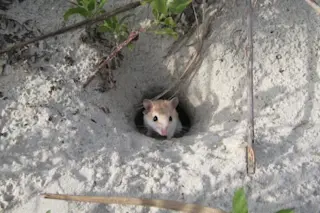Image credit: Vera Domingues/Hopi Hoekstra, Harvard University A burrow is just a hole in the ground, right? Wrong. Different species of mice have very different burrow designs, and a new study suggests that a mouse's architectural know-how is written in its DNA: Mice constructed these species-specific burrows even when they had never seen one before. Researchers examined the burrowing behaviors of two related mouse species. The deer mouse makes a simple burrow, just a short tunnel that leads to a nest. The closely related oldfield mouse puts a little more feng shui in its design, extending the entry tunnel and adding a back door for quick escapes from the nest. To see if the blueprints for these burrow designs were based on instinct, researchers brought the mice into the lab. The mice reproduced in the lab and researchers raised the offspring of each species in cages, free from the influence ...
Blueprints for Mouse Burrows Coded in Their DNA
Discover the fascinating burrow designs of mice, driven by genetics and instinct rather than learned behavior.
More on Discover
Stay Curious
SubscribeTo The Magazine
Save up to 40% off the cover price when you subscribe to Discover magazine.
Subscribe













